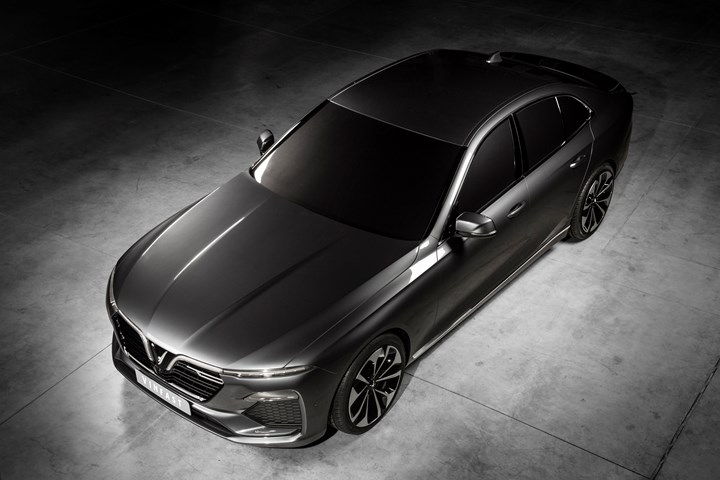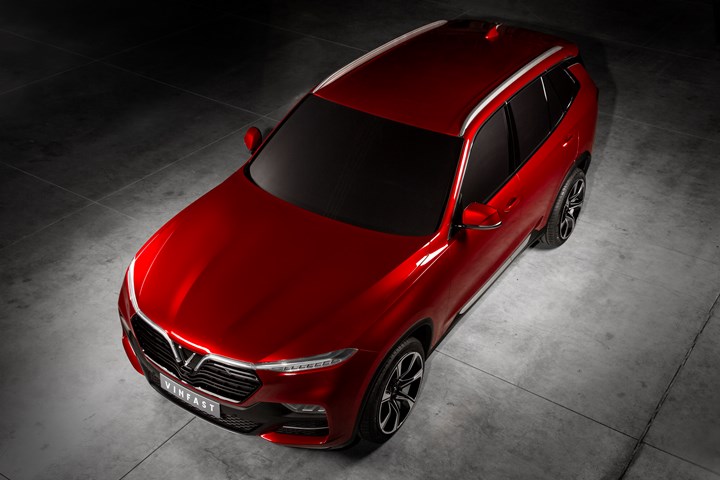VinFast and Digital Speed
When you’re talking about a 21-month development from design to production, you’re talking about blistering speed. And that’s what a startup has accomplished.

(Images: VinFast)
VinFast is a company that was established in Vietnam in June 2017. At the 2018 Paris Motor Show in October it had a stand with two vehicles on display, the LUX SA2.0, an SUV, and LUX A2.0, a sedan. Look at that again: startup in June 2017 and showing vehicles October 2018. Fast. And in June 2019 its factory, which has an annual capacity of 250,000 vehicles, went live. Meaning that the clock from the start ran 21 months. Which is really fast.
A large part of the clearly accelerated approach that this privately held company is taking is predicated on working with existing firms with deep roots within the auto industry. For example, it worked with BMW for the underpinnings of the two vehicles (one from the previous generation X5 and the other from the previous gen 5 Series). What’s more, the engines are sourced from BMW, the 2.0-liter N20 engine, which was re-engineered by AVL.
Vehicle designs were done by Pininfarina. And they worked with Magna on setting up the factory that the company has built in Hai Phong.

VinFast LUX A2.0 sedan
And the staffing at the top includes people like James DeLuca, CEO, who had previously been the executive vice president, Global Manufacturing, Manufacturing Engineering, and Labor Relations, General Motors, and director of Design Dave Lyon, who had more than 20 years in design at GM, where he’d worked on models including the first Cadillac CTS and the original Chevy Volt.
(And while on the subject of GM, it is worth noting that GM and VinFast established a partnership in June 2018 through which VinFast is the exclusive distributor for the Chevrolet brand in Vietnam and has assumed the ownership of the GM factory in Hanoi.)
Digital Speed
But there is another element that has allowed VinFast to go so very fast: the utilization of digital tools through which the vehicles were developed in concert with the factory. In effect, it was simultaneous design/engineering/build taken to a new level.
VinFast worked with Siemens Digital Industries Software, using the company’s digital tools, including Xcelerator software and Totally Integrated Automation (TIA), with the former having a huge effect on design of product and process, and the latter facilitating factory floor operation in an efficient manner. For example, there is Siemens’ automation equipment in the press shop, paint shop, body shop, assembly shop, sub-assembly- and engine shop. Simatic Controllers are used for robots and conveyor lines, including safety functionality. The engineering framework TIA Portal is used for programming automation tasks from the press shop through to the final assembly.
Dave Lauzun, vice president of the automotive industry for Siemens Digital Industries Software, who’d had 30 years’ experience in auto before joining the company, acknowledges that because VinFast is working with a nearly full suite of Siemens products there is the ability to closely connect and orchestrate operations.
The Value of Digital Twins
But he also explains that even long-standing companies can go faster: “One of the things that speeds up production or operations is connecting digital twins—virtual representations. These can be representation of the factory or the design of the platform. It can be of the fluid dynamics surrounding the vehicle. It can be the reach of a robot.

VinFast LUX SA2.0 SUV
Lauzun goes on to say, “If you integrate them, tie them together with a digital thread, then when you change something in design, the manufacturing folks know immediately.” And this quick access to the latest information means that informed decisions can be made rapidly.
Often, it doesn’t go like that. Consequently, there are problems that arise. Lauzun—and remember, he’s been there—says, “The gaps between system and the lags in timing can cause errors and delays. If the manufacturing people don’t get the information about the latest design change for three weeks, not only is that three weeks lost, but there’s a big opportunity for error because they may have designed automation that doesn’t fit.” And there’s also a considerable amount of investment that can go for naught.
In the case of VinFast, they’re using Teamcenter software as backbone of collaboration for product lifecycle management (Lauzun describes Teamcenter as “the glue that holds it all together”) and NX software for computer-aided design, manufacturing and engineering (CAD/CAM/CAE), to develop the digital twin of cars and production. Then Teamcenter connects the digital twin with a consistent digital thread.
Simulation Matters
Lauzun says that VinFast did a significant amount of simulations during the development of its vehicles. “They know before they cut steel that the aerodynamics are right, the thermodynamics are right and the crash will be right.”
Lauzun suggests that a big difference between many new automotive companies—not just VinFast, but the global array of startups—and traditional OEMs is that “The newer companies are living and dying by the simulation,” that they are using simulations for everything from thermodynamics to the formability in stamping dies.” “The simulation becomes the decider.” He explains, “In the past, we would simulate, but then prove it out physically. Simulation was guidance, but the physical test was the deciding factor.”
However, newer companies are relying more on the results obtained through simulation, which Lauzun says correlates quite good with the physical world. This approach leads to faster development times.
This is not to say that physical testing is going to go away entirely. But Lauzun says that one way that companies that have long relied primarily on physical tests can begin to move more rapidly is to put the simulation and physical testing people under the direction of one person. That way they can begin to develop the levels of confidence needed.
And presumably to go faster. Much faster. Like VinFast.
RELATED CONTENT
-
On Fuel Cells, Battery Enclosures, and Lucid Air
A skateboard for fuel cells, building a better battery enclosure, what ADAS does, a big engine for boats, the curious case of lean production, what drivers think, and why Lucid is remarkable
-
Jeeps Modified for Moab
On Easter morning in Moab, Utah, when the population of that exceedingly-hard-to-get-to town in one of the most beautiful settings on Earth has more than doubled, some people won’t be hunting for Easter eggs, but will be trying to get a good look at one of the vehicles six that Jeep has prepared for real-life, fast-feedback from the assembled at the annual Easter Jeep Safari.
-
Multiple Choices for Light, High-Performance Chassis
How carbon fiber is utilized is as different as the vehicles on which it is used. From full carbon tubs to partial panels to welded steel tube sandwich structures, the only limitation is imagination.


.jpg;width=70;height=70;mode=crop)






